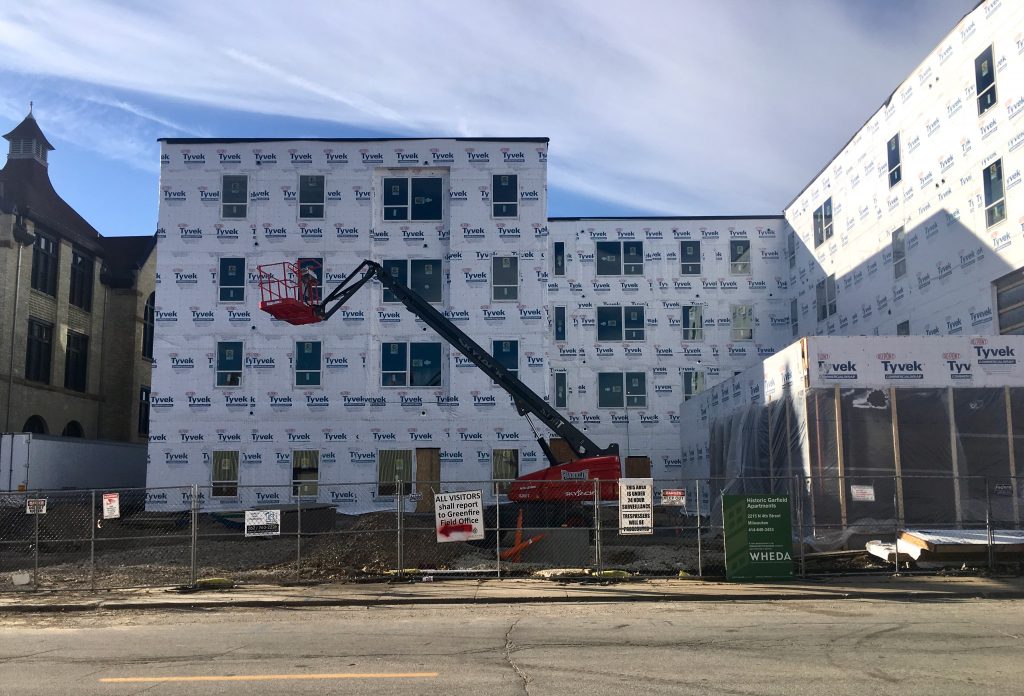Solutions for Affordable Housing Crisis?
City has shortage of affordable housing, high eviction rate. Experts share ideas at panel.

The Milwaukee Common Council Housing Trust Fund is helping fund affordable units in The Griot apartments, currently being built on North Avenue and 4th Street, just next to the Historic Garfield Apartments. Photo by Elizabeth Baker.
Danita Graham is a 30-year old mother living in Milwaukee. Despite having a master’s degree in social work, serving as a PEARLS for Teen Girls program coordinator and sitting on a development board in the Harambee neighborhood, she feels like she’s drowning as she struggles to obtain affordable housing.
“I’m in all of these systems, but yet, even in understanding real estate and development … I cannot afford a low-income property, even at the lowest level,” Graham said. “Even for an educated woman who’s communicated and worked in all these places, it’s not feasible.”
Graham voiced these concerns at a recent panel discussion, MKE Housing: Crisis & Opportunities, hosted by Global Shapers Milwaukee, a group of young adults committed to action and dialogue in the community, and ACTS Housing. About 35 people attended, including representatives from neighborhood groups, community organizations, corporations, and banks, as well as concerned residents.

Danita Graham, program coordinator at PEARLS for Teen Girls (left), asks panelists a question as Jermaine Alexander (right), director of housing at the Sherman Park Neighborhood Association, listens. Photo by Elizabeth Baker.
Rebecca Stoner, a Global Shaper and ACTS director of development, said the book “Evicted,” by Harvard professor Matt Desmond about the housing crisis in Milwaukee, and the 50-year anniversary of the fair housing marches this year inspired conversations about these issues among the Global Shapers and throughout the city.
Global Shapers and ACTS sought to bring together people on the front lines of the city’s housing crisis to highlight the good work being done in Milwaukee, identify gaps where additional strategy and investment are needed and raise awareness for others to get involved in solutions.
Panelists were Irma Yépez Klassen, housing policy director in Mayor Tom Barrett’s office; Kori Schneider-Peragine, senior administrator of the Inclusive Communities Program at the Metropolitan Milwaukee Fair Housing Council; and Dorothy York, associate director of ACTS. ACTS Executive Director Michael Gosman moderated.
Gosman cited statistics that set Milwaukee apart when it comes to affordable housing. One-fifth of people in the United States spend more than half their income on housing, compared to one-third of Milwaukeeans. One of every eight Milwaukee renters moves because of evictions. Decades of segregation have increased disparities, and the metro area has the lowest black suburbanization rate in the country.
The panelists agreed: It’s a challenge too big for any one entity to overcome, but too often in Milwaukee organizations struggle to take a step back and make adjustments when something isn’t working.
Graham reiterated these frustrations. “How can we work together better to really make a difference, to bring that humanness to it?” she asked.
Awareness is key, said Schneider-Peragine. Her work with the Inclusive Communities Program supports neighborhood integration so that people of color and low-income families can have access to better employment and education.
“It’s like the water we swim in is segregation, and there are things that we don’t even question — when you go to a restaurant and you don’t see another person of color, or you go trick or treating and you know immediately who’s not from your neighborhood.”
City officials recognize this reality and are working to maintain affordable units as new development booms throughout downtown and nearby neighborhoods, Schneider-Peragine said. She cited a newly proposed ordinance in the city Zoning, Neighborhoods and Development Committee that would require all new privately financed apartment developments of 20 units or more to include 10 percent affordable units.
In addition, the city is talking directly with residents and local business and community leaders to make sure new developments, particularly expansion of the streetcar in Bronzeville and Walker’s Point, won’t push residents out of their neighborhoods.
Gosman said he disagrees with Desmond, the author of “Evicted,” who believes housing vouchers are the answer for Milwaukee. “The housing voucher system is broken,” Gosman said. “Anything that’s meant to be a safety net shouldn’t be rationed.”
Rental assistance isn’t the only resource available, Stoner said, “and if more people knew that, then we would be able to more clearly see the gaps of people who we’re not getting to with the current resources available.” For example, ACTS helps low-income people own homes.
York said that ACTS Housing’s one-stop shop model assists people in financing a home and helps them work through the buying and renovation process with real estate agents, contractors and repairmen. Providing these resources under one roof eliminates barriers to home ownership, York said.
The panel discussion left both Stoner and Graham with mixed feelings.
Resources exist, but Stoner acknowledged that navigating them is incredibly challenging. She said that housing organizations “are not talking to each other, and there is a lot of red tape and documentation collection that makes it cumbersome to figure it all out.”
However, she was excited to see so many people passionate about fixing these problems.
Graham agreed. She said she often sees the same people discussing the same issues at events like this. At this panel, though, she said she was happy to see several new people.
“It was good to be here today to see different faces of people who are looking for answers and educating themselves — to know that they are interested in changing the dynamic.”
This story was originally published by Milwaukee Neighborhood News Service, where you can find other stories reporting on eighteen city neighborhoods in Milwaukee.





















There is a simple solution to the high housing costs facing Milwaukee’s most challenged neighborhoods. I call it a rent correlation law. Simply put, it would be a law that limits monthly rent to 2.5% of the building’s assessed value.
I’ve collected a fair amount of data on this and the ONLY neighborhoods in which rents exceed 2.5% of AV per month are the most economically challenged ones. Everywhere else charges less than 2.5%. For example, right now there is a duplex near 34th and Center assessed at $38,000 which charges $625 for each 2-bed unit ($1,250 total or 3.3% of AV/month). This law would reduce that rent to $475/unit. There is a similar apartment in a 4-unit building near 61st and Stevenson advertised at $599, but that building is assessed at $161,600 (1.5% of AV/month). This law would have no impact on that property, and that’s by design.
By correlating rent to assessed value, you encourage landlords in challenged neighborhoods to improve their properties so they can charge more rent, or alternatively, you ensure that tenants in low value housing pay only for what they get. The law would be enforced by tenants, so no extra government budget or bureaucracy would be necessary. Any government or charity program that currently supplements rents could either help the same number of people at a lower cost or help more people at an equal cost. Reduced rents would decrease evictions significantly, thereby increasing housing stability, which has many benefits for individuals and society.
I look forward to any feedback.
People need jobs with decent wages so they can afford to live and fulfill basic needs. Taxpayers and Foundations are not going to accept handouts forever. There are limits to budgets.
The Milwaukee area has an abundance of older worn out buildings and empty properties that need renovation and investment. Some local groups like Layton Boulevard West Neighbors, Walnut Way, Habitat, have taken on new and older renovation projects. They have had a number of examples of success for more than a decade. This kind of effort is needed on a massive scale and would produce thousands of labor jobs.
Racine has started a project of rent free 8’x12′ housing units for homeless vets. This is another niche solution example that provides people in need a start in life again.
Wisconsin government is squandering $3 Billion in taxpayer funds for the Foxconn scam. This kind of funding commitment could have made a major stimulus in this area in actual renovation and labor job creation across the state. Wisconsin imports more than $13 Billion in fossil energy annually, and much of this is used to heat and cool old buildings.
More than $7 Billion could be saved annually through comprehensive integrated renovation of building stock with energy efficiency, conservation, solar electric, and thermal mass storage for heating and cooling buildings. This would create thousands of needed labor jobs, putting money into families that can now afford to rent and own homes. In the process renovate needed repairs on foundations, drainage, lead lateral replacements, mold, lead, and asbestos abatement, modernization, roofs, porches, etc.
Stimulate this kind of effort by tripling of Focus on Energy funds, Low Income Weatherization Funds, a carbon tax on fossil energy for tax credits for this effort, Water Department matching funds, MMSD stormwater abatement grants, and a sale tax exemption for local labor and materials. Consumers save over $7 Billion annually, wage earners support families paying rents and owning buildings, and paying taxes, and further stimulating local economies.
Rent at $625 is not the issue — that sounds like a great price.
I would encourage Danita Graham to look into her monthly expenses and look for ways to cut her own costs of living.
As a program coordinate for Pearls for Teen Girls – I would assume she is earning in vicinity of $17.50 an hour.
@ $17.50 x 40 hours a week = $700 before taxes and personal deductions (child support, insurances, 401k contribution, etc.)
On a sidenote: there are numerous companies hiring, so working a 2nd job is a great way to work harder to get ahead. Even minimum wage ($7.25) for 10 hours a week would add another $72.50 before taxes.
I find it so frustrating when these articles profile people and not give any real details about their backstory. The young women profiled here has a Master’s Degree and cannot find affordable housing? What are the friggin details people? is she in debt up to her nose in student loans? lots of kids to take care of and no dad in the picture? It’s hard to buy into the story when you don’t know the real facts behind someone’s situation. Given so few facts, my assumption is that she is deep in debt and can’t afford the kind of place “she wants”, or she just doesn’t want to pay the market rate and with her degree and income level she does not qualify for low income housing. Do a better job telling the whole story author.